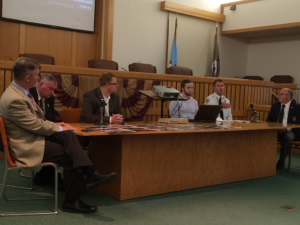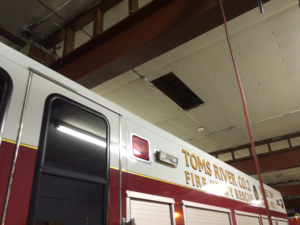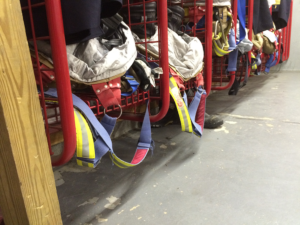
TOMS RIVER – At a public hearing about a new fire station being built downtown, most of the residents’ concerns were about the cost of the building and how it would affect parking.

The meeting was held on April 20. There will be another held from 7 to 9 p.m. on May 2 in the L. Manuel Hirschblond room in the Toms River Town Hall, 33 Washington St.
The meetings are to educate the public about a plan to approve the construction of a new fire building that would house both fire companies 1 and 2. The public is being asked to vote on this on Saturday, May 13 from 2 to 9 p.m.
The question would ask voters to approve a $14 million bond, but Fire Commissioner Craig Ambrosio said the total cost would likely be less. They would be seeking grants from places such as the Federal Emergency Management Agency. By law, they have to put the largest amount on the ballot.
The $14 million is giving people sticker shock, Toms River Fire Department Business Administrator Brian Kubiel said. It would amount to an average increase for homeowners of $26-40 a year. However, this could be reduced by grants.
There were more than 50 people in the meeting. More than half of them were in firefighter dress uniforms.
Inadequate Buildings
The two buildings that the fire companies currently use are old and have a host of problems, fire officials said. To illustrate the problems, they brought in architectural firm Manns Woodward, the company that would likely do the design.
Evan Gray, the project manager, said that Station 1, on Robbins Street, is 104 years old. The roof leaks. Air and moisture is getting in through the windows and doors. A hundred years ago, a horse-drawn pumper was used. Now, the equipment is much bigger and the demands on the station are greater. The rule is that the garage should be 10 feet longer than the longest vehicle. The new ladder truck doesn’t even fit in the building.

Station 2, on Water Street, is 95 years old, he said. It suffered 40 inches of standing water from Superstorm Sandy. It took 5,000 man hours to get the station back on its feet again. It’s in the flood plain for the 100-year storm. This doesn’t mean that the storm happens every 100 years. It means that there is a 1 percent chance it could happen in any year.
“Is it really worth it to gamble on it?” he asked.
“Since Sandy, it has flooded approximately six times,” fire commissioner Jesse Sipe said.
Robert Manns, the principal architect, said that when building a fire station, they look first and foremost at the health and safety of the people spending the most time there. It has to conform to building codes. “It has to be the last building standing” in an emergency.
Station 2 also has difficulty with fire trucks exiting onto busy Water Street, across four lanes of traffic, and then backing into the bays on the return.
Sipe said there are 4 inches of room between the truck’s mirrors and the garage doors.
“I can’t remember an accident but I frequently drive out of the bay. It’s only a matter of time” before there’s a major crash, he said.
Why Here?

Residents wanted to know why the fire officials chose this particular location, on the northern slope of a free parking lot across from Wells Fargo on Irons Street.
Gray said they looked at locations, and this one would provide the best access to all of the downtown area.
One resident asked how the fire trucks would be able to access a lot of the downtown area, since there is a lot of traffic, especially getting onto Route 9.
Kubiel said the county planning board might allow some changes, such as a controlled signal that fire responders can change.
“This is a heavy fire load area,” fire commissioner Craig Ambrosio said. There are a lot of buildings built closely together and a squad needs to be available to respond quickly. Plus, a lot of the volunteers live in South Toms River and Beachwood. Moving farther north would increase response times.
Parking and Price

Residents had the most concerns about parking and price. One business owner asked for more security for his employees walking to the parking lot.
Fire officials said there would still be no net loss of parking spaces. Public parking will still be available at the Irons Street location, even with the building there. When the two older buildings are vacated, parking spaces will open up.
Kubiel said there was nothing stopping the fire district from asking Wells Fargo bank if they could use some of their spaces.
Resident Dennis Galante asked where the $14 million cost came from, if there is no architectural plan.
“If we’re having a referendum, the public needs to know what it is borrowing money for,” he said.
Manns said that their past experience building fire stations, plus prevailing wage rates, and the competitive bid price were all factored into the estimate.
Ambrosio said that the way fire companies are governed by law, they have to hold the referendum first. They were not allowed to pay for an architectural rendering yet.
What they did know was some facts about the timeline, and for future use.
Manns said it would take 12-18 months from breaking ground to completion.

The new building would be cheaper to maintain, Manns said, because of the updated technology. For example, LED lighting and motion sensors cut down on electric costs. A slab to store heat would prevent the station from losing heat when the bays open.
There is room for expansion, he said. In fact, most of the third floor would be empty. There wouldn’t even be walls. They would be filled in when any expansion happens, and based on what is needed. Since volunteerism is on a decline nationally, it could be that this area would be needed to house paid fire fighters in the future. It might be bid as an alternate.
“We will be volunteer for as long as possible,” Ambrosio said. “But we would be negligent if we didn’t prepare for the contingency of a paid fire company.
Alizar Zorojew, executive director of Downtown Toms River, which works to improve business in town, said he supports the new fire house. “It will free up two ratables,” he said. “We believe this would be an enhancement to downtown.”
He said that there are concerns among the business owners about parking, but as long as there is no net loss, then it would be an improvement.
Resident George Humphris asked what the chances were of getting a tenant into a building that floods all the time.
Manns said the new tenant would be able to make changes and flood proof because they wouldn’t have the big garage bays.







